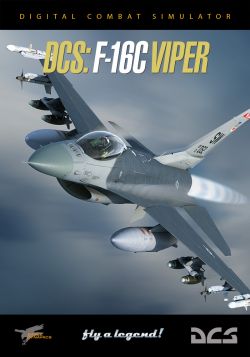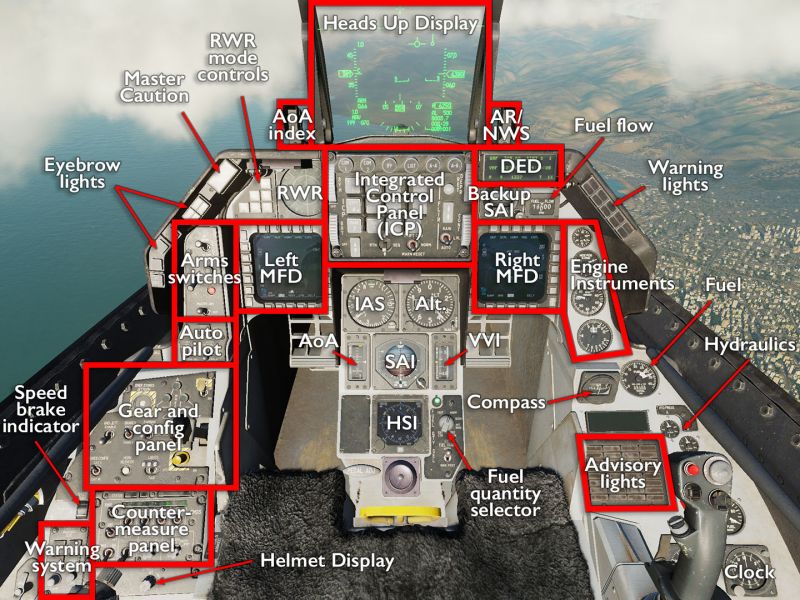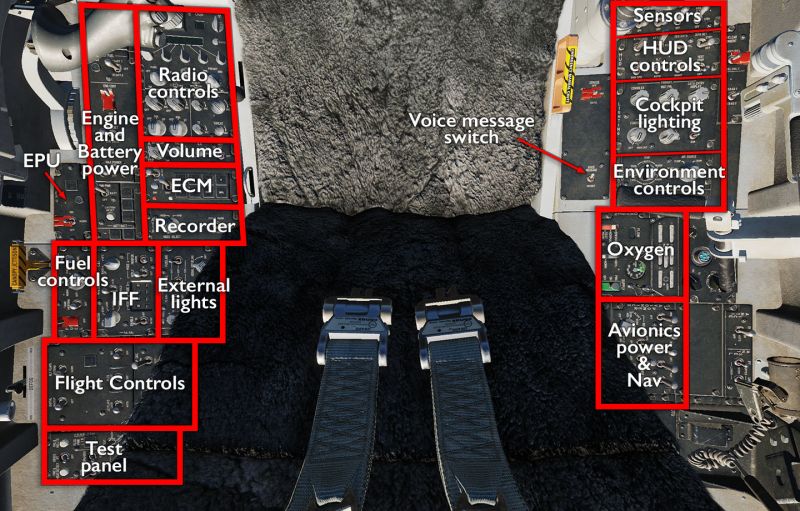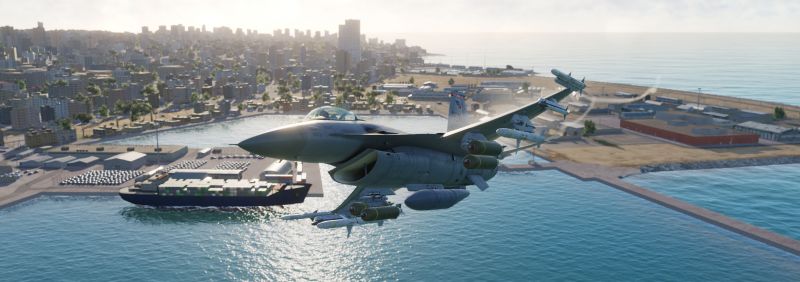F-16C Viper: Difference between revisions
m (→�) |
m (→�) |
||
| Line 44: | Line 44: | ||
=== Getting into the air === | === Getting into the air === | ||
In spite of being a full-sim aircraft (albeit still an incomplete one) and a rather advanced one at that, given all the extra bits that have been bolted onto the airframe over the years, the F-16C is surprisingly easy to get going. As with most modern aircraft, its navigation alignment process can take a while, but the rest is very familiar and brief to anyone who's gotten into the DCS swtich-flipping. It is less involved than the [[FA-18C_Hornet|F/A-18C]] and a far cry from the multiple interdependent systems [[A-10C_Warthog|A-10C]]. | |||
As always the {{Key|RWin}}{{Key|Home}} “cheat” key combo is available to automate the start-up process, and the manual and [[#Links_and_files|Chuck's guide linked below]] give a full account of the procedure. The broad strokes are: | |||
* Main Power to Battery, Jet Fuel to Start position, and Throttle out of detent. | |||
<br><small>(The engine will start on its own and spool up.)</small> | |||
* Turning power on, warning your surroundings, and checking for errors. | |||
* Turning engines on, starting with the ''right'' one.<br><small>(Right engine crank, right throttle to idle, monitor the spool up.)</small> | |||
* Turning on most of the avoinics.<br><small>(GPWS, MFDs, HUD, radar altimeter, bleed air, FCS.)</small> | |||
* Star aligning the INS — this will take a while. | |||
* Turning the ''left'' engine on. | |||
* Turning the remaining systems on and setting them up.<br><small>(Oxygen, hook, flaps, anti-skid, radar, trim, wings, ADI, RWR, etc etc etc.)</small> | |||
* Carefully start removing the brakes so you can get into position. | |||
* Line up, extend the launch bar, hook up (default bind {{Key|U}}), and run up the engines. | |||
* Kick in the afterburners (this may require manipulation of the finger lift levers depending on your settings) and ''keep your hands off the stick'' as the catapult and (hopefully accurate) trim and flaps setting get you in the air and climbing. | |||
=== Shooting something === | === Shooting something === | ||
Revision as of 23:42, 25 September 2020
| This is an alpha module.
This module is still being developed and is missing central features and equipment options. While it is playable, it may have major bugs, and procedures may have inconsistent or unexpected results. The intrepid and very interested may want to buy it; others should probably wait for a more stable or complete release. |
Once upon a time, there were some deep rumblings within the defence establishment from a self-proclaimed “Fighter Mafia” that claimed that post-WWII aircraft development had taken a wrong turn. Instead of the on-going trend of expensive higher-tech, missile-laden, huge-engined multi-purpose fighters and bombers, this group advocated cheap, simple, nimble, single-purpose aircraft focused on two key roles: in-close dogfighting (because BFR was a fool's errand) and close air support where energy-manoeuvrability (E-M) was the one performance measure to rule them all.
The result of the Mafia's efforts were three aircraft: the A-10, the F-15, and the F-16. The A-10 ended up as a high-tech, missile-laden, far-from-single-purpose (if still CAS-focused) sensor array and bomb truck. The F-15 became a costly, high-tech, missile-laden, huge-engined BFR interceptor (and later a multi-purpose bomber as well, just to rub it in). And the F-16 — the finest example of their core tenets — became a high-tech, missile-laden, huge-engined, BFR/dogfighter/fighter-bomber platform onto which every conceivable piece of aircraft tech could be (and was) bolted, creating the multiest-rolliest thing in the sky. Zero for three for the Fighter Mafia, but still a highly impressive legacy.
The F-16C Viper is the last DCS module to complete the trifecta and an attempt give people a reason to finally abandon Falcon BMS. It is also, almost ironically and in spite of how it evolved over the years, still the aircraft that most closely matches the initial ideas of the E-M fighter: a ridiculously manoeuvrable dogfighter that just so happened to be an excellent airframe for a ton of other roles.
Features
Much like — some would argue much more than — the F/A-18 that was its main competition in the Lightweight Fighter trials, the F-16C is a multi-role fighter, working as the USAF bulk workhorse for many decades. As such, again much like with the Hornet, a full feature list would become ridiculously long. The main highlights are:
- Almost unrivalled manoeuvrability.
- Moon-rocket engine performance — if you somehow get outmanoeuvred, just fly away and try again.
- A superbly user-friendly HOTAS and MFD setup.
- A highly capable and almost as user-friendly in-your-face interface in the form of the Integrated Control Panel (ICP) and Data Entry Display (DED).
- Backup steam gauges (in case the fancy displays go down) that are still almost reasonably and usefully placed.
- A highly capable navigation and sensor suite tied in with datalinks to keep your situational awareness high.
- Helmet-cued AIM-9X over-the-shoulder IR missiles for up-close work and AMRAAMS for BFR duty.
- HARMs and CBU-97s for SEAD and DEAD missions.
- More Mavericks than any rivet-counter finds reasonable.
Missing features
The F-16C Viper is marked as Early Access in the DCS store for very good reasons. A lot of forum drama has been caused by a constant push and pull between work on the Viper and the completion of the Hornet module, and many systems and tools familiar to old BMS players are still missing — more still will never come.
- Most of the fancy navigation trickery on the DED (VIP and VRP offsets, optimal cruise modes, mark points etc).
- Proper sensor integration with HUD marking, cursor zero, and hand-off modes.
- All forms of inertially guided weapons (JDAM:s, JSOW:s, CBU guidance kits).
- Advanced HARM target modes and the HARM Targeting System pod.
- Proper weapon setup and HSI and MFD preprogramming via data cassette (some of it is cheated and automatically populated, such as SAM locations on the HSI).
- Ground radar.
In particular, ED has stated that some much-loved features from BMS will never come because the block simulated in the Viper module never had them:
- GBU-39 SDB:s
- JSOW-B:s
- Terrain-following radar and LANTIRN overlays.
Flying the F-16C
Cockpit overview
Getting into the air
In spite of being a full-sim aircraft (albeit still an incomplete one) and a rather advanced one at that, given all the extra bits that have been bolted onto the airframe over the years, the F-16C is surprisingly easy to get going. As with most modern aircraft, its navigation alignment process can take a while, but the rest is very familiar and brief to anyone who's gotten into the DCS swtich-flipping. It is less involved than the F/A-18C and a far cry from the multiple interdependent systems A-10C.
As always the RWinHome “cheat” key combo is available to automate the start-up process, and the manual and Chuck's guide linked below give a full account of the procedure. The broad strokes are:
- Main Power to Battery, Jet Fuel to Start position, and Throttle out of detent.
(The engine will start on its own and spool up.)
- Turning power on, warning your surroundings, and checking for errors.
- Turning engines on, starting with the right one.
(Right engine crank, right throttle to idle, monitor the spool up.) - Turning on most of the avoinics.
(GPWS, MFDs, HUD, radar altimeter, bleed air, FCS.) - Star aligning the INS — this will take a while.
- Turning the left engine on.
- Turning the remaining systems on and setting them up.
(Oxygen, hook, flaps, anti-skid, radar, trim, wings, ADI, RWR, etc etc etc.) - Carefully start removing the brakes so you can get into position.
- Line up, extend the launch bar, hook up (default bind U), and run up the engines.
- Kick in the afterburners (this may require manipulation of the finger lift levers depending on your settings) and keep your hands off the stick as the catapult and (hopefully accurate) trim and flaps setting get you in the air and climbing.
Shooting something
BVR engagement
Using the HARM
Links and files
- Chuck's F-16C Viper guide at Mudspike.
- DCS: F-16C Viper in the DCS shop.
More information
- General Dynamics F-16 Fighting Falcon on wikpedia.
- F-16 Fighting Falcon on globalsecurity.org
- Matt Wagner's F-16 Viper series.
- Wonkotron's Quick Usage Guide






